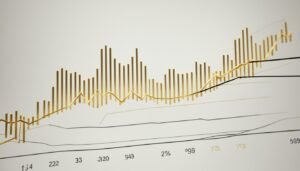Gold, the timeless “safe-haven” asset, has been a symbol of wealth and power for millennia. Its value transcends symbolism; it’s a tangible asset that has consistently held its worth throughout history.
But what factors influence the price of gold? Specifically, how do global events influence gold prices?
Let’s embark on this captivating journey.
Key takeaways
Here’s a summary table highlighting the 10 key points from the entire article on “How Global Events Influence Gold Prices”:
| Key Points | Description |
|---|---|
| 1. Economic Instability | Gold prices often rise during economic instability as investors seek safe-haven assets. |
| 2. Political Turmoil | Political events can create market uncertainty, driving investors towards gold and pushing its price up. |
| 3. Central Banks’ Role | Central banks’ buying and selling activities can influence gold prices. |
| 4. Inflation | Gold is often viewed as a hedge against inflation. When inflation rates rise, gold prices can increase. |
| 5. Global Trade | Trade policies and agreements can impact gold prices. Import restrictions or tariffs on gold can affect its supply and demand dynamics. |
| 6. Currency Values | Gold prices are often inversely related to the value of the U.S. dollar. |
| 7. Gold Market Dynamics | The gold market is influenced by various factors including supply and demand, interest rates, and investment trends. |
| 8. Gold and Stock Market | Gold and the stock market often move in opposite directions due to their different risk profiles and the role of economic indicators. |
| 9. Gold as an Investment | Gold can be bought in various forms such as physical gold, gold ETFs, gold mining stocks, and gold futures contracts. |
| 10. FAQs | Various FAQs related to gold prices and their influencing factors are addressed, providing readers with a quick reference guide. |
How Global Events Influence Gold Prices
The price of gold is not static. It fluctuates, mirroring the ebb and flow of the ocean, influenced by a myriad of factors. Among these, global events play a pivotal role.
But how exactly do they impact gold prices?
Let’s dissect this.
Economic Instability and Gold Prices
When the economy is on shaky ground, gold often shines the brightest. Why? Because in times of economic uncertainty, investors flock to gold as a safe haven.
It’s seen as a stable store of value that can weather financial storms.
So, when economic instability hits, whether due to a recession, a financial crisis, or even a global pandemic, gold prices tend to rise.
- The 2008 Financial Crisis: The global financial crisis of 2008 is a prime example of this phenomenon. As the crisis unfolded, investors sought refuge in gold, driving its price up from around $800 per ounce at the start of 2008 to over $1,200 per ounce by the end of 2009.
- COVID-19 Pandemic: The global pandemic has also had a significant impact on gold prices. As economies around the world grappled with lockdowns and recessions, gold prices soared, reaching an all-time high of over $2,000 per ounce in August 2020.
Political Turmoil and Its Impact on Gold
Political events, such as elections, wars, or changes in government policies, can create uncertainty in the market.
This uncertainty often drives investors towards gold, pushing its price up.
- Geopolitical Tensions: For instance, during the geopolitical tensions between the U.S. and North Korea in 2017, gold prices saw a significant uptick. The uncertainty surrounding the situation led investors to seek the safety of gold, driving up its price.
- Elections: Elections, particularly in major economies like the U.S., can also influence gold prices. The uncertainty surrounding policy changes and their potential impact on the economy can lead to increased demand for gold.
The Role of Central Banks in Gold Pricing
Central banks around the world hold vast amounts of gold in their reserves. Their buying and selling activities can influence gold prices.
- Buying Activities: When central banks increase their gold reserves, it can drive up demand and, consequently, the price of gold. For instance, in 2018, central banks added a whopping 651.5 tonnes to their reserves, the second highest annual total on record, contributing to a rise in gold prices.
- Selling Activities: Conversely, when central banks sell gold, it can increase supply in the market, potentially driving down prices. However, such instances are relatively rare.
Inflation and Gold Prices
Gold is often viewed as a hedge against inflation. When inflation rates rise, the value of currency falls, and the cost of goods and services increases.
In such scenarios, investors turn to gold to preserve their wealth, which can lead to an increase in gold prices.
- 1970s Inflation: During the high inflation period of the late 1970s, gold prices skyrocketed, peaking at $850 per ounce in 1980.
- Modern Day: In recent times, concerns about potential inflation due to extensive government stimulus measures have also driven investors towards gold.
Impact of Global Trade on Gold Prices
Trade policies and agreements between countries can also impact gold prices. For example, import restrictions or tariffs on gold can affect its supply and demand dynamics, influencing its price.
- Import Restrictions: Countries like India, one of the largest consumers of gold, often impose import restrictions to manage their trade deficits. These restrictions can reduce the demand for gold and potentially impact its price.
- Tariffs: Trade wars and tariffs can also influence gold prices. For instance, during the U.S.-China trade war, uncertainties led to increased demand for gold, pushing up its price.
The Influence of Currency Values on Gold Prices
Gold prices are often inversely related to the value of the U.S. dollar. When the dollar weakens against other currencies, gold becomes cheaper for investors holding other currencies, which can increase demand for gold and drive up its price.
- Dollar Weakness: For example, during periods of dollar weakness in 2007-2008 and 2011-2012, gold prices rose significantly.
- Dollar Strength: Conversely, when the dollar strengthens, gold prices often fall as gold becomes more expensive for investors holding other currencies.
Understanding the Gold Market Dynamics
The gold market is a complex ecosystem influenced by various factors. Understanding these dynamics can help investors make informed decisions.
Supply and Demand of Gold
Like any commodity, gold’s price is influenced by supply and demand. Factors affecting supply include mining production and central bank sales, while demand is driven by jewelry and industrial use, investment, and central bank purchases.
- Supply Factors:
- Mining Production: Changes in mining output can influence gold supply. For instance, disruptions due to labor strikes or environmental regulations can reduce supply and potentially drive up prices.
- Central Bank Sales: As mentioned earlier, central bank sales can increase gold supply in the market, potentially impacting prices.
- Demand Factors:
- Jewelry and Industrial Use: Gold is widely used in jewelry and various industries, including electronics and dentistry. Changes in these sectors can influence gold demand.
- Investment: Investor demand for gold, influenced by various economic and political factors, plays a significant role in determining gold prices.
- Central Bank Purchases: Central banks are major players in the gold market. Their buying activities can significantly influence gold demand and prices.
Gold and Interest Rates
There’s an inverse relationship between interest rates and gold prices. When interest rates are low, the opportunity cost of holding gold decreases, making it more attractive to investors, which can drive up its price.
- Low Interest Rates: For instance, during the period following the 2008 financial crisis, interest rates were kept low by central banks around the world. This environment was conducive for gold prices, which rose significantly.
- High Interest Rates: Conversely, during periods of high interest rates, such as the early 1980s, gold prices can come under pressure as the opportunity cost of holding gold increases.
Gold as an Investment
Gold is a popular investment choice due to its perceived stability and potential for high returns. It can be bought in various forms, such as physical gold (bars, coins), gold ETFs, gold mining stocks, and gold futures contracts.
- Physical Gold: Bars and coins are the most traditional formof investing in gold. They offer direct ownership and high liquidity but come with storage and insurance costs.
- Gold ETFs: Gold Exchange Traded Funds (ETFs) offer a convenient way to invest in gold without the need for physical storage. They track the price of gold and can be bought and sold like stocks.
- Gold Mining Stocks: Investing in gold mining companies is another way to gain exposure to gold prices. However, these stocks also carry company-specific risks.
- Gold Futures Contracts: Gold futures are contracts to buy or sell a certain amount of gold at a set price on a future date. They allow investors to speculate on the future price of gold.
FAQs on How Global Events Influence Gold Prices
Conclusion
The influence of global events on gold prices is a testament to the interconnectedness of our world. Economic, political, and social events across the globe can send ripples through the gold market, causing prices to fluctuate.
Understanding these dynamics can provide valuable insights for investors and individuals alike, helping them navigate the complex landscape of gold prices.








